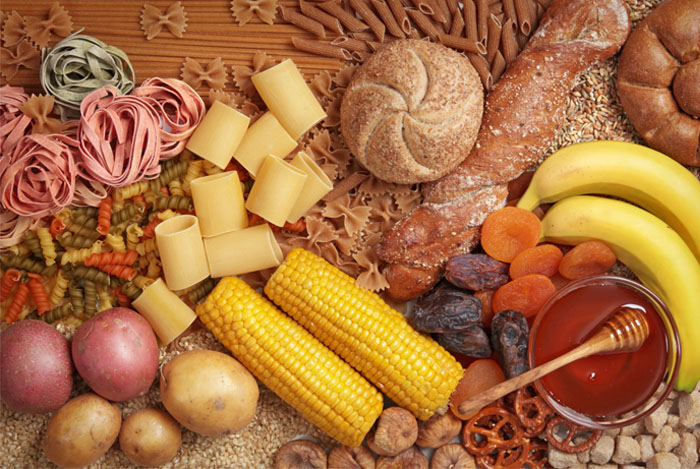Good Carbs vs Bad Carbs – What is the Difference?
Carbohydrates play a significant role in our diet they are the body’s main source of energy.
They are essential for good health and are a requirement for survival.
Right now, there is a heated debate regarding good carbs and bad carbs.
This topic gets even more confusing.
Some experts tackle the glycemic index.
Others put the blame on certain ingredients like refined sugar and high fructose corn syrup.
Some want to determine your metabolic rate.
While some carbs are really bad, there are lots of carbohydrates that give tremendous benefits to your body.
So how do you know which is which?
What are Carbohydrates?
Carbohydrates (or simply ‘carbs’) are the body’s main energy source and are an essential part of a healthy balanced diet.
This macronutrient must not be avoided and it is important to know that not all carbs are the same.
Carbs can be grouped into two categories – complex (the good) and simple (the bad), based on their chemical structure and how the body breaks them down.
Carbohydrates are made up of hydrogen, carbon, and oxygen and are arranged in small units called monosaccharides or simply ‘sugar’.
The Physicians Committee for Responsible Medicine describes simple carbohydrates simply – sugars that are easily digested and quickly absorbed.
They are considered the small carbohydrates because they are only made up of one or two units.
These are the molecules that provide the sweet taste in food.
On the other hand, complex carbohydrates are composed of sugar molecules joined together like a coil or necklace.
They are the bigger carbohydrates and are made up of at least 20 or more monosaccharides linked together.
Bigger carbohydrates are called polysaccharides and may contain hundreds of monosaccharides joined together in various ways.
Another type of complex carbohydrates is called oligosaccharide, a type of carbohydrate that is in between monosaccharides and polysaccharides in size.
It contains 3-20 monosaccharides linked together.
Why do You Need to Eat Carbohydrates?
Many people think of carbohydrates to be fattening, but the truth is that they are the primary nutrient that your body needs.
A zero-carb diet is very hard to achieve and is unsustainable because it can cause dangerous effects to your body.
Energy Supply
All your daily activities require energy.
Even breathing or walking requires energy.
Carbohydrates are the body’s primary energy source – the nutrients that get used first, before protein, fat, or alcohol.
The sugar needed for your daily energy requirement is glucose; its source is from the sugars and starches you eat.
Experts suggest that 45% to 60% of your diet must come from carbohydrates.
Along with insulin, sugar and starch get converted into simple sugar during the process of digestion.
Glucose then enters the cell wall.
The excess sugar from food is stored in the liver, muscles, and other parts of the body.
If not used, it gets converted to fat.
Boost Mood
According to studies, carbohydrates have the ability to promote the production of the brain chemical serotonin (1).
This particular ability is what protein lacks.
People who follow a very low carbohydrates diet, allowing only 40 grams of carbs per day, may experience more anger, anxiety, and depression than those who follow a high-carb, low-fat diet, focusing on whole grains, beans, and fruits.
Promote Weight Loss
Research from Brigham Young University studied the diet of middle-aged women for about two years.
Researchers have found that those who focused more on fiber intake lost weight while those who reduced their fiber intake gained it (2).
A lot of carbohydrates contain indigestible fiber, a type of complex carbohydrate that provides bulk to your diet.
Heart-Friendly
Increasing soluble fiber intake, a form of fiber commonly found in carbohydrate food such as beans and oatmeal, by 10 grams every day can lead to a 5% reduction in the bad cholesterol or LDL (low-density lipoprotein) level.
Help Blast Stored Fat
A study shows that eating your breakfast composed of “slow-release” carbohydrates three hours before working out may help blast more fat.
Eating slow-release carbohydrates such as whole oats or bran doesn’t cause as high of an increase in blood sugar as consuming refined carbohydrates does.
Insulin levels don’t spike either.
A rise in insulin signals the body to store fat.
Keeping lower levels of blood sugar may help burn fat. (3)
Keep Your Memory Sharp
A study from Tufts University revealed that people who eliminated carbohydrates from their diet performed more poorly on tasks involving memory function than those who reduced calories, but kept carbohydrates.
Once carbohydrates were reintroduced, their cognitive skills return back to normal.
This study proves that food can have a direct impact on cognitive behavior.
The popular low-carb diet can have a negative effect on cognition and thinking.
Although the brain uses glucose as its main energy source, it doesn’t have the ability to store it for future use.
The body converts carbs into glucose and carries them to the brain via the bloodstream.
Glucose is then immediately used by neurons for energy.
Reducing the intake of carbohydrates decreases the brain’s energy source, which is the reason experts hypothesize that diets low in carbs may affect cognitive and memory function (4).

Different Types of Carbohydrates
The American Diabetes Association classified carbohydrates into three types:
- Sugars
- Fiber
- Starches
You often see or hear terms such as added sugar, sugar alcohols, processed grains, reduced-calorie sweeteners, complex carbohydrate, sweets, whole grains, and refined grains.
No wonder determining the type and the right amount of carbs to eat can be very confusing.
Sugar
Sugar is referred to as fast-acting or simple carbohydrate.
It comes in two types:
- Added sugar – sugar added during the processing of products such as cookies or heavy sugar syrup.
- Naturally occurring sugar – sugar found in fruit or milk.
When you check the Nutrition Facts label, the amount of sugar indicated includes both natural and added sugars.
There are different kinds of sugar.
Some common names include brown sugar, table sugar, honey, molasses, cane sugar, beet sugar, powdered sugar, turbinado, agave nectar, maple syrup, and high fructose corn syrup.
Table sugar may also be listed by the name sucrose.
Lactose is the name of the sugar found in milk, while fructose is also known as fruit sugar.
You can easily recognize sugar labels because their name ends with “ose”; for instance: maltose, glucose, dextrose, and lactose.
Fiber
Did you know that fiber can only be found in plant foods?
Fiber is the indigestible part of plants such as whole grains, fruits, vegetables, and legumes.
When you eat dietary fiber, it passes through your intestines and cannot be digested.
Animal products such as milk, eggs, poultry, fish, and meat don’t contain fiber.
The recommended amount of dietary fiber to eat every day should be 25 to 30 grams.
Most people don’t consume this much fiber in their diet, so an increase in fiber intake would be beneficial to almost anyone.
Fiber is an essential factor for your digestive health and helping you feel full and satisfied.
Furthermore, a diet high in fiber can reduce bad cholesterol levels.
Rich sources of fiber include:
- Fruits and vegetables, particularly those with edible seeds (e.g. berries) and skin (e.g. corn, apple, and beans)
- Whole grains (e.g. whole wheat pasta, whole grain cereals, whole grain bread)
- Beans and legumes (e.g. pintos, black beans, kidney beans, chickpeas, lentils, white beans)
- Nuts of different kinds: almonds, walnuts, and peanuts are a rich source of healthy fat and fiber, but they contain lots of calories in little amounts, so watch your portion size
Getting your fiber from food is better than taking supplements.
Apart from fiber, these foods contain important vitamins, minerals, and other essential nutrients.
Be sure to increase your fiber intake slowly to prevent constipation and stomach irritation.
Also, be sure to increase your fluid intake.
Starch
Starch can be obtained from different food sources:
- Dried beans, peas, and lentils such as kidney beans, split peas, pinto beans, and black-eyed peas.
- Starchy vegetables such as lima beans, potatoes, corn, and peas.
- Grains such as rice, oats, and barley.
In the US, most of the grain products are made from wheat flour, which is made into bread, pasta, and crackers.
The grain group is divided into two – the refined grain and the whole grain.
Grains are composed of three parts, namely germ, bran, and endosperm.
Bran is the hard shell coating the grain.
It is rich in fiber, minerals, and B vitamins.
The next layer is the germ; it is loaded with Vitamin E, fatty acids, and other nutrients.
At the center, the endosperm contains the starch.
When we say ‘whole grain’, it means that the entire grain kernel is included in the food.
Eating whole grain food, which contains the endosperm, bran, and germ, lets you get all the nutrients the three components have to offer.
Refined grain food usually contains only the starchy part or the endosperm, so you are missing the fiber, Vitamin B, and other nutrients of bran and germ.

Good and Bad Carbohydrates
What makes a carb food bad?
Why are good carbs like whole grains, legumes, and vegetables so good for us?
Let’s learn their difference below.
What is a “Good” Carb?
Good carbs are:
- Rich in different varieties of nutrients
- Low in calorie density, meaning you can consume filling amounts and feel satisfied without worrying about exceeding your calorie intake
- Low in saturated fat and sodium
- Very low in cholesterol
- Rich in natural fiber that helps lower insulin levels, blood sugar, and bad cholesterol; in addition, fiber-rich foods help you lose weight easily because they often contain fewer calories
- Devoid of anything refined
Nowadays, refined sugar makes up more than 20% of total calories eaten every day.
This is a huge concern because your body is built to metabolize unrefined carbohydrates.
Your body is clueless about high fructose corn syrup; you are not equipped to handle such kinds of sugar.
This daily intake of refined sugar has been linked to current epidemics of Type 2 diabetes.
What is a “Bad” Carb?
Bad carbs are:
- High in refined sugars such as corn syrup
- Low in essential nutrients
- Low in fiber
- High in white sugars or the so-called ‘natural sugars’ such as fruit juices and honey
- Often high in trans fats and saturated fat
- Often high in sodium
Based on the bullet points above, you can easily see how eating good carbs can lead to strong health and healthy body.
On the other hand, a diet rich in sugar and processed carbs can wreak havoc on your health.
Several sources of research revealed that excessive consumption of refined carbohydrates can lead to metabolic health disorders such as glucose intolerance, metabolic syndrome, and Type 2 diabetes.
Refined carbohydrates seem to cause an increase in blood sugar levels, leading to a sugar crash.
This triggers more cravings for sugar-loaded foods (5 ,6).
The association between carb intake and heart disease remains unclear.
However, numerous studies have proven that high carbohydrate intake (mainly refined grains) can increase the risk of developing coronary heart disease (7).
Since they often lack essential nutrients, they are often termed as “empty calories”.
Added refined sugars are absolutely the worst type of carbohydrates and are linked to different sorts of diseases (8, 9).
On the other hand, numerous studies on healthy, natural carbohydrates such as legumes, fruits, vegetables, and whole grains show that consumption of these foods can lower the risk of developing chronic diseases and improve overall health (10, 11)
How to Choose Good Carbs
There are 5 key points when choosing between good carbs and bad carbs.
Check the Ingredients
Nowadays, there is a battle against the use of high fructose corn syrup (HFCS).
It is a food ingredient that has become a very popular alternative to natural sugar.
In the past four decades, the incidence of obesity and other metabolic diseases skyrocketed (12).
Although HFCS hasn’t been established as the direct culprit, substantial evidence is hard to ignore.
An animal study revealed the effects of different sugar solutions and results shows that an isolated fructose solution, compared to other sugars, resulted in a significant increase of circulating triglycerides (13).
Another study also found that the intake of HFCS can cause a negative reaction on the metabolic outcomes, hippocampal function, and neuroinflammation if taken excessively during the period of adolescence (14).
Today, many food manufacturers are saying that they’ve switched from HFCS to plain table sugar in their processed foods and soft drinks.
The problem is that soft drinks are liquid calories, regardless if they’re made with corn syrup or sugar.
Liquid calories can be a problem if you are trying to shed pounds because they are broken down easily.
The biggest challenge is to compensate all those excess calories when you feel hungry later in the day.
Don’t Focus on Glycemic Index
Foods with a high glycemic index are foods that can increase blood sugar levels.
However, there are also nutritious foods such as carrots, which have a high GI.
Researchers suggest that you should focus not on the GI, but on how healthy the foods are.
A study of more than 284,000 individuals has found that your risk of Type 2 diabetes lowers as you increase your intake of whole grains.
What is interesting about the study is that an increase in whole grain consumption also increases the glycemic load.
But does this really matter as long as the effect would be better health and lesser risk of developing diabetes (15)?
Higher intake of whole grains instead of refined grains was linked with lower risk of diabetes and lower weight.
Having a high glycemic index didn’t undo such significant benefits.
Published by the Academy of Nutrition and Dietetics, a review of 140 studies regarding the relation of Body Mass Index (BMI) and carbohydrate intake found that these two variables have no connection.
Scientists concluded that people shouldn’t be concerned about glycemic index (16).
Lower BMI has been linked to the intake of low-fat, high-carbohydrate diets, but only those which contain good carbohydrates.
This dietary strategy emphasized on fiber-rich carbs is good for health and weight control.
A study among overweight adults, who were placed on a healthy carb diet, found that those on a high-GI, high-carb diet fared better than the participants on a low-GI, low-carb diet (17).
Researchers concluded that the overall dietary pattern based on natural whole foods such as fruits, whole grains, fish, and vegetables is more important in improving cholesterol levels and insulin sensitivity.
The glycemic load is nothing to be worried about (18).
Walking along the cereal and bread aisles, you can see products packed with refined grains and sugar, claiming they’re rich in fiber because of the addition of wheat bran.
Make sure you choose fiber-rich carbs over foods that have added fiber.
The problem with this is that most studies proving the health benefits of fiber-rich foods base their research on healthy whole foods that are naturally rich in fiber.
They are whole grain cereals, fresh vegetables, and fresh fruits.
Eat Carbohydrates Rich in Fiber
So, better stick to the real thing.
Your body has a natural relationship with natural, whole foods, not those stripped foods that have only had a little bran added to them.
To make sure you are getting the real thing when grocery shopping, check the first ingredient on the label.
Whole grains such as sprouted whole grain kernels or whole wheat flour should be listed.
In addition, check what else is included.
Whole grain bread or pasta won’t be that beneficial if its is combined with sorbitol, honey, corn syrup, molasses and other sugar, as well as sodium.
Lessen Consumption of Flour
Weight loss gurus often suggest eating more vegetables and fruits.
Since fruits and veggies contain fewer calories, make sure you are consuming nine servings per day.
Also, your diet should emphasize itself more on seafood, legumes, nonfat dairy, foods and starchy vegetables such as corn, potatoes, and yams.
If you are trying to lose excess pounds, some grains are better than others.
Eat “wet” grains instead of the “dry” ones.
Grains that are ideal for shredding pounds are whole oats, brown rice, and unhulled barley – grains that didn’t undergo any processing or grinding of their kernels to flour.
When cooked, these grains only contain about 500 calories for every pound, meaning you can consume them until you are comfortably full.
The grains you need to limit are those in which the kernels have been processed into flour.
After grinding, the flour is denser in terms of calories.
Limit your intake of whole grain crackers, bagels, and breads.
Whole grain breads have about 1,200 to 1,500 calories for every pound.
Ounce for ounce, whole grain fat-free chips have about 1,600 to 1,750.
Certainly, you are getting three times as much calories than eating unprocessed, unground whole grains.
For you to remember which is which, think about it as dry vs. wet.
Unground grains like brown rice and whole oats are cooked in water while highly processed; ground grains are all dry, making them more compact yet less filling.
The water adds a more stomach-filling experience, but not in calories.
Whole wheat pasta is the only exception to the flour rule.
This is because pasta is not consumed dry.
It is cooked in water and broken down slowly unlike crackers, breads, and dry cereals.
Whole wheat pasta leaves you feeling full on fewer calories.
Combine the pasta with tomato sauce and vegetables and it will be even better for losing excess weight.
Cook Your Own Meal
One of the best ways to avoid obesity and be in your optimal shape is to cook your own meal and avoid eating at fast food places.
Plant a vegetable garden and prepare a platter of fresh veggies and fruits.
Fill your pantry with natural healthy carbs and replenish it daily.
If a vegetable garden seems impossible to make, go grocery shopping and look for whole, healthy food like potatoes, brown rice, fresh fruits and vegetables, beans, and whole grains.
Pick nonfat dairy products, chicken, fish, and lean meat.
How about visiting a local farmer’s market?
This is the best place to find healthy carbs harvested at their peak of flavor.
When you get home, go to your kitchen and take pleasure in cooking your meal.
Conclusion
As you can see, not all carbs are bad for you.
On the contrary, if you want to be healthy, you MUST eat some carbs because carbs are the “gasoline” that powers your brain.
The problem is to figure out which ones are made from relatively healthier ingredients.
Hopefully, this article will help you to make sense of this problem.
Let me know in the comments if you have other tips!
FDA Compliance
The information on this website has not been evaluated by the Food & Drug Administration or any other medical body. We do not aim to diagnose, treat, cure or prevent any illness or disease. Information is shared for educational purposes only. You must consult your doctor before acting on any content on this website, especially if you are pregnant, nursing, taking medication, or have a medical condition.
HOW WOULD YOU RATE THIS ARTICLE?







What carbs are recommended to take to enhance athletic performance?
It looks like basically everything! but what food doesnt have carbs?
Not much, but some of the more watery vegetable like cucumbers and celery don’t have any carbs
Does honey belong to bad carbs? I know it’s sugary food but, still, it’s claimed to be extremely beneficial. So, where is the truth? Should I exclude honey from my diet? What portion of honey is considered optimal?
I’ve always thought that everything is good in moderation. A cheeseburger once in a while, a piece of cake at a restaurant…All these things make our life a little better.
Is white really so bad? Sorry to know that, I love it a lot. And I haven’t noticed any side effects of consuming white rice…
How can I distinct whole-grain bread from processed one? Can I bake healthy bread at home?
I enjoyed this article, thank you for spending your time for sharing such valuable information! I only don’t understand what wet carbs are. I’d appreciate if you explained this! Thanks!